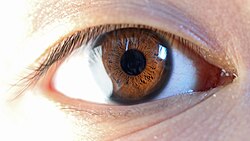

A limbal ring is a dark ring around the iris of the eye, where the sclera meets the cornea. [1] It is a dark-colored manifestation of the corneal limbus resulting from optical properties of the region. [2] The appearance and visibility of the limbal ring can be negatively affected by a variety of medical conditions concerning the peripheral cornea. [3] It has been suggested that limbal ring thickness may correlate with health or youthfulness and may contribute to facial attractiveness. [3] [4] The thickness of the limbal ring varies by pupil dilation: When the pupil is larger, the limbal ring narrows. [5] Some contact lenses are colored to simulate limbal rings. [1]
